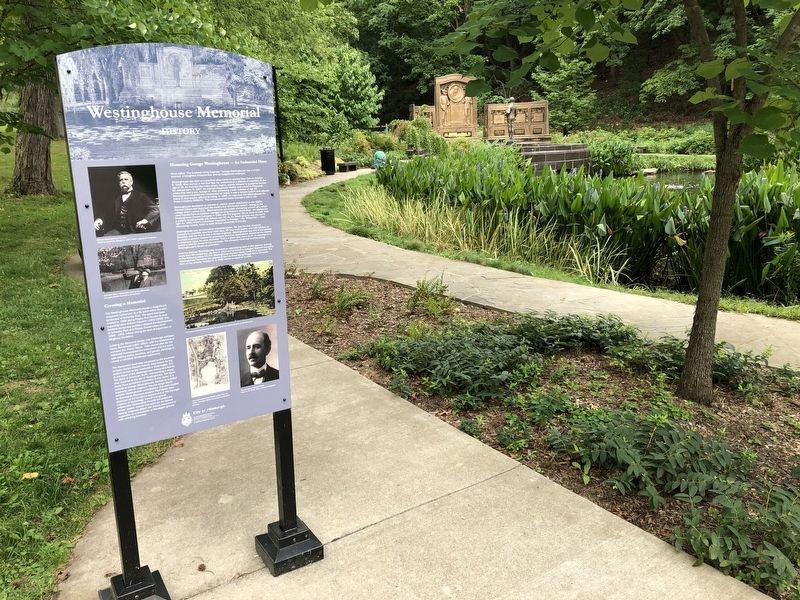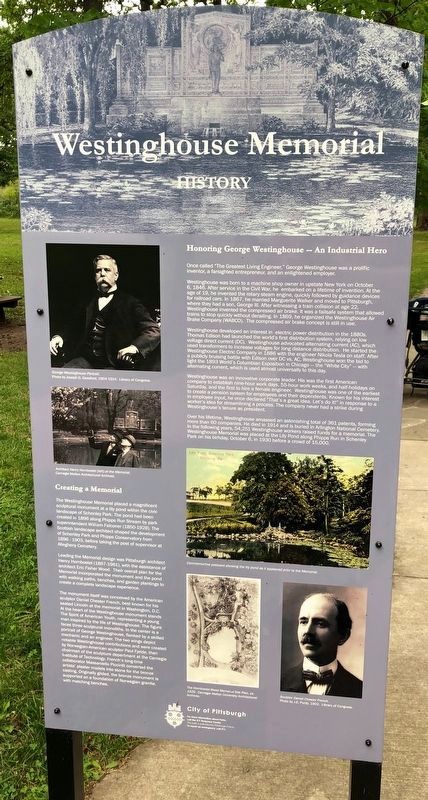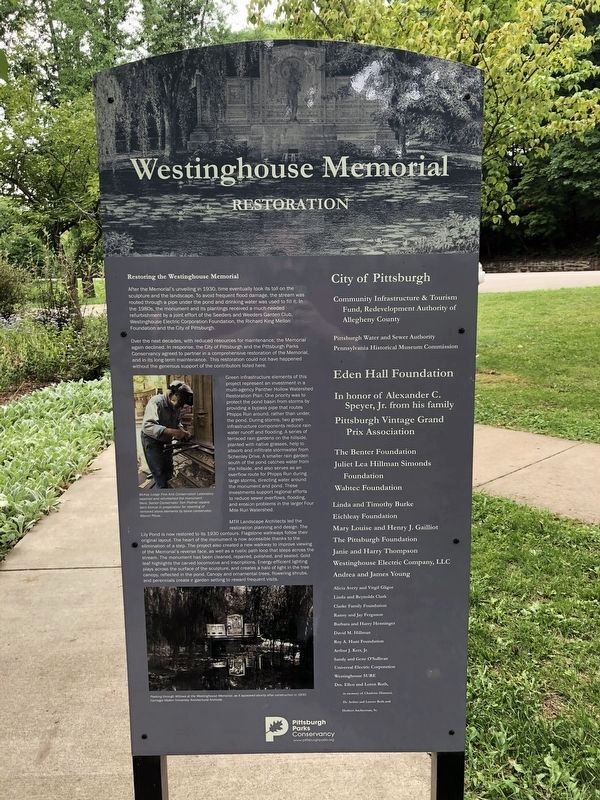Squirrel Hill South in Pittsburgh in Allegheny County, Pennsylvania — The American Northeast (Mid-Atlantic)
History / Restoration
Westinghouse Memorial
Honoring George Westinghouse -- An Industrial Hero
Once called "The Greatest Living Engineer," George Westinghouse was a prolific inventor, a farsighted entrepreneur, and and enlightened employer.
Westinghouse was born to a machine shop owner in upstate New York on October 6, 1846. After service in the Civil War, he embarked on a lifetime of invention. At the age of 19, he invented the rotary steam engine, quickly followed by guidance devices for railroad cars. In 1867, he married Marguerite Walker and moved to Pittsburgh, where they had a son, George III. After witnessing a train collision at age 22, Westinghouse invented the compressed air brake. It was a failsafe system that allowed trains to stop quickly without derailing. In 1869, he organized the Westinghouse Air Brake Company (WABCO). The compressed air brake concept is still in use.
Westinghouse developed an interesting electric power distribution in the 1880s. Thomas Edison had launched the world's first distribution system, relying on low voltage direct current (DC). Westinghouse advocated alternating current (AC), which transformers to increase voltages for long distance distribution. He started the Westinghouse Electric Company in 1886 with the engineer Nikola Tesla on staff. After a publicly bruising battle with Edison over DC vs. AC, Westinghouse won the bid to light the 1893 World's Columbian Exposition in Chicago — the "White City" — with alternating current, which is used almost universally to this day.
Westinghouse was an innovative corporate leader. His was the first American company to establish nine-hour work days, 55-hour work weeks, and half-holidays on Saturday, and the first to hire a female engineer. Westinghouse was one of the earliest to create a pension system for employees and their dependents. Known for his interest in employee input, he once declared "That's a great idea. Let's do it!" in response to a worker's idea for streamlining a process. The company never had a strike during Westinghouse's tenure as president.
Over his lifetime, Westinghouse amassed an astonishing total of 361 patents, forming more than 60 companies. He died in 1914 and is buried in Arlington National Cemetery. In the following years, 54,251 Westinghouse workers raised funds for a memorial. The Westinghouse Memorial was placed at the Lily Pond along Phipps Run in Schenley Park on his birthday, October 6, in 1930 before a crowd of 15,000.
Creating a Memorial
The Westinghouse Memorial placed a magnificent sculptural monument at a lily pond within the civic landscape
Leading the Memorial design was Pittsburgh architect Henry Hornbostel (1867-1961), with the assistance of architect Eric Fisher Wood. Their overall plan for the Memorial incorporated the monument and the pond with walking paths, benches, and garden plantings to create a complete landscape experience.
The monument itself was conceived by the American sculptor Daniel Chester French, best known for his seated Lincoln at the memorial in Washington, D.C. At the heart of the Westinghouse monument stands The Spirit of American Youth, representing a young man inspired by the life of Westinghouse. The figure faces three sculptural monoliths. In the center is a portrait of George Westinghouse, flanked by a skilled mechanic and an engineer. The two winds depicts notable Westinghouse contributions and were created by Norwegian-American sculptor Paul Fjelde, then chairman of the sculpture department at the Carnegie Institute of Technology. French's long-time collaborator Massaniello Piccirilli converted the artists' plaster models into stone for the bronze casting. Originally

Photographed By Devry Becker Jones (CC0), September 11, 2020
3. History / Restoration Marker
The Westinghouse Memorial can be seen in the background.
Restoring the Westinghouse Memorial
After the Memorial's unveiling in 1930, time eventually took its toll on the sculpture and the landscape. To avoid frequent flood damage, the stream was routed through a pipe under the pond and drinking water was used to fill it. In the 1980s, the monument and its plantings received a much-needed refurbishment by a joint effort of the Seeders and Weeders Garden Club, Westinghouse Electric Corporation Foundation, the Richard King Mellon Foundation and the City of Pittsburgh.
Over the next decades, with reduced resources for maintenance, the Memorial again declined. In response, the City of Pittsburgh and the Pittsburgh Parks Conservancy agreed to partner in a comprehensive restoration of the Memorial, and in its long-term maintenance. This restoration could not have happened without the generous support of the contributors listed here.
Green infrastructure elements of this project represent an investment in a multi-agency Panther Hollow Watershed Restoration Plan. One priority was to protect the pond basin from storms by providing a bypass pipe that routes Phipps Run around, rather than under, the pond. During storms, two green infrastructure components reduce rain water runoff and flooding. A series of terraced rain gardens on the hillside, planted with native grasses, help to absorb and infiltrate stormwater from Schenley Drive. A smaller rain garden south of the pond catches water from the hillside, and also serves as an overflow route for Phipps Run during large storms, directing water around the monument and pond. These investments support regional efforts to reduce sewer overflows, flooding, and erosion problems in the larger Four Mile Run Watershed.
MTR Landscape Architects led the restoration planning and design. The Lily Pond is now restored to its 1930 contours. Flagstone walkways follow their original layout. The heart of the monument is now accessible thanks to the elimination of a step. The project also created a new walkway to improve viewing of the Memorial's reverse face, as well as a rustic path loop that steps across the stream. The monument has been cleaned, repaired, polished, and sealed. Gold leaf highlights the carved locomotive and inscriptions. Energy-efficient lighting plays across the surface of the sculpture, and creates a halo of light in the tree canopy, reflected in the pond. Canopy and ornamental trees, flowering shrubs, and perennials create a garden setting to reward frequent visits.
Erected by Pittsburgh Parks Conservancy, City of Pittsburgh, Pennsylvania.
Topics. This historical marker is listed in these topic lists: Architecture • Arts, Letters, Music • Industry & Commerce • Railroads & Streetcars. A significant historical date for this entry is October 6, 1846.
Location. 40° 26.378′ N, 79° 56.583′ W. Marker is in Pittsburgh, Pennsylvania, in Allegheny County. It is in Squirrel Hill South. Marker is on West Circuit Road just south of Schenley Drive, on the right when traveling north. Touch for map. Marker is at or near this postal address: 100 W Circuit Rd, Pittsburgh PA 15217, United States of America. Touch for directions.
Other nearby markers. At least 8 other markers are within walking distance of this marker. George Westinghouse Memorial (within shouting distance of this marker); World War I Memorial (about 700 feet away, measured in a direct line); College of Fine Arts (about 700 feet away); Baker Hall (about 700 feet away); Doherty Hall (approx. 0.2 miles away); Schenley Park (approx. 0.2 miles away); Yi-Sheng Mao (approx. 0.2 miles away); Porter Hall (approx. 0.2 miles away). Touch for a list and map of all markers in Pittsburgh.
Credits. This page was last revised on February 2, 2023. It was originally submitted on September 14, 2020, by Devry Becker Jones of Washington, District of Columbia. This page has been viewed 331 times since then and 24 times this year. Photos: 1, 2, 3. submitted on September 14, 2020, by Devry Becker Jones of Washington, District of Columbia.

